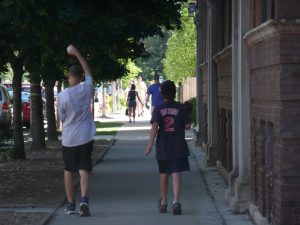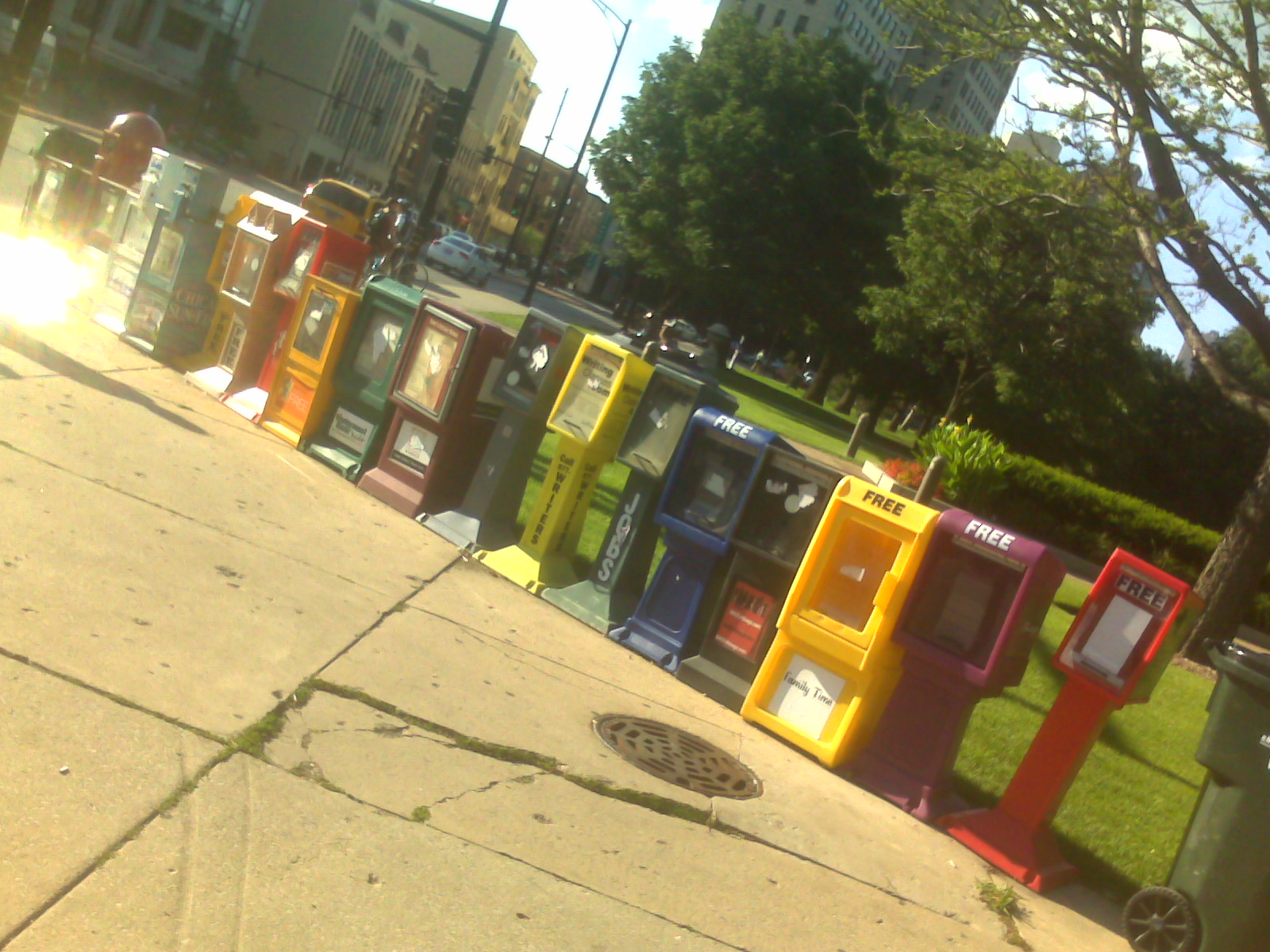These two boys were on their way to the school playground to play ball.
It happens to be the day of a Cubs game. Wrigleyville (around Wrigley Stadium) was choc a block with people. There were so many people leaving the stadium they had actually taken over the road and were stopping traffic from moving.
I came out of my workshop at 3pm and it was like fighting a tide to walk anywhere they weren’t walking.
I in fact took a long walk, past an area recommended by my travel guide as pretty (all of Wrigleyville is pretty. I think this one was unique in that the street was more like our Inner West streets – only about 3m wide, houses straight onto the street (sort of English I’d imagine). Also walked past a cemetery and some trendy shops (heaps of ‘girl’s’ boutiques, ballet shops, maternity and baby shops and antiques. And a candy shop. Finally I took a bus home.
And before this afternoon’s workshop I had a swedish massage. Heaven!! I took a different route to class (via the El) and got just a little lost. But it’s improv: I arrived 20 minutes late and still hadn’t missed much.
The workshop was run by a guy called Seth Weitberg. I’m sure you can google him and find a list of his accomplishments.
His take on object work in scenes (i.e. miming objects and doing things with them), is that the degree to which you invest in specificity and realism of your object work is the degree to which the audience can invest in the realism and specificity of your characters. He adds that poor and uninformed object work can be a distraction. (Not sure how much that is true, but it is a pleasure to see it done well).
Seth outlined four aspects of object work:
1. weight and dimension (weight indicated by tension in the hands, dimension indicated by using the object)
2. go slower than you think and go bigger than you think
3. every object is a process (i.e. use it and it will take you somewhere)
4. if that then what else (if I have a Star Wars figurine, what kind of lounge will I sit in?)
Some more wisdom:
– the WAY we hold or touch something gives information about the character
– we rarely pick up or hold objects with all our fingers together (pick up a glass and see), so we shouldn’t mime it with fingers closed
– start doing something and you will discover something
– a guy standing clicking a pen is 1000 ties more interesting than a guy just standing there
– we often try to get the feel of an object by imagining it – try instead feeling it then seeing it
– stage time is “adrenalined” time: we have practiced to slow down our words, we need to slow our gestures too
– clowning actually shows an object being created so we can get its size and shape – give the audience (and other players) time to catch up to what your idea is by taking the time to “describe” it
– for slowness of movement, watch Charlie Chaplin (with real objects)
– in improv land we so often do things perfectly. In reality there is often a snag (button done up wrong, sleeve inside out), so take your time and let it stuff up
– make sure not to make the stage smaller when doing object work (e.g. setting up a really small kitchen) – use the fourth wall, and feel free to lean out into the audience to make it even bigger
– physical activity underscores the scene emotionally
– imagine the environment is someone who’s dying to know more about you, but can only be told through touch
– choices breed choices
– don’t use yoour own clothes on stage, use your “impro clothes”, your “impro glasses”, your “impro shoes” – which are imaginary and as you describe them physically or verbally – Seth recommends a neutral palette of clothing (no logos, nothing too flashy) for this reason – so the audience can easily imagine it different to what they see
Some exercises:
– Spolin exercise: given an environment, not allowed to move from your chair, find things in the environment (2 players)
– in super super slo mo, 2 players mime a transaction (e.g. I give you a 20 from my wallet, you count change from the till); do it again in super slo mo; then in just slo mo, then ‘real time’ – get feedback from your partner about the “reality” of it
– using magic silly putty, sculpt something out of it, till everyone gets what it is, then collapse the silly putty and pass it on
– from Mick Napier – make a list of the objects you often find yourself miming in a scene. Make a list of other things you could go for – to build your awareness and expand your range
– in 2s or 3s do a simple task like buttering bread and call out what you are doing at all times. Get your audience to give you feedback on what worked (or not) – especially weight and dimension initially, then further realism issues (e.g. stability of the counter)
– spend some time watching what your hands do when you pick up a cup or drink or make a call – use a mirror or a video camera; then mime it – consider doing object work as you’re on the phone to people
– observe routines in the environments you are in (what else is on a bus besides seats and a driver?)
– choose a repetitive action and do it in scenes (folding laundry, washing dishes, sweeping) and practice it till it feels natural; do it also while you are on the phone to friends; once you get good at this repetitive action, add the next step (dry or put the dishes away)
– choose an emotional state and engage with an object in a way to show this (joyfully hold a quill pen). In theory this is what should happen in emotional replays, but we don’t always see object work in the set up scene…
Some good actions to practice:
– pouring and drinking water (you usually don’t bring your hand to your chin with a cup, but many improvisors do)
– writing
– doors (which side, which direction, what arc? latch or door knob?)
– reading – spend 20 minutes watching yourself reading a magazine – all the intricacies and mechanics of turning a page
– going up stairs and ladders – pay attention to Chaplin again, do some clowning workshops – usually people look up when going up, and lean their weight forward
Some other stuff: Seth says iO scenes are all about relationships; in New York it’s all about the game; in LA it’s character…. so hmmmm!





